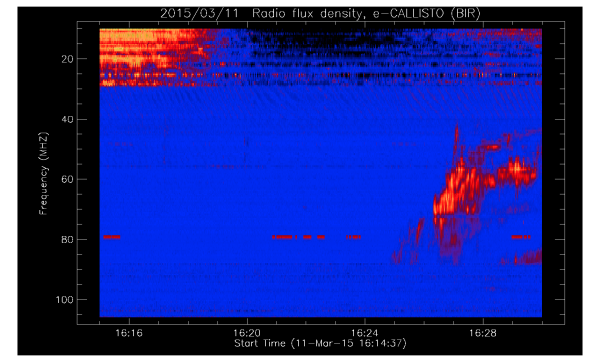Ionospheric Effects, Flare History, and Dick Donnelly
| Nugget | |
|---|---|
| Number: | 251 |
| 1st Author: | Hugh Hudson |
| 2nd Author: | Peter Gallagher |
| Published: | 27 April 2015 |
| Next Nugget: | EOVSA and Gamma-rays |
| Previous Nugget: | Quiscent Filament |
Introduction
From the point of view of the physics of solar flares, including especially the extreme events, the Earth's ionosphere has played a particularly interesting role. Carrington's original flare in 1859 famously led to ionospheric effects, starting with the geomagnetic "crotchet" observed simultaneously with the flare. The interpretation of this phenomenon, now known prosaically as a "solar flare effect" or SFE, required the concept of ionizing radiation. In 1859 this was in the future, awaiting the work of Heaviside, Röntgen, and Einstein (for example). Thus our understanding of the Earth's ionosphere and of the physics of solar flares had to develop together.
Major developments in our understanding of flare-related ionospheric effects still were happening in the postwar era of the 1950s and beyond. Many kinds of "Sudden Ionspheric Disturbance" (SIDs) had become observable, each with its own acronym: SEA, SCNA, SWF, SPA, SFD, etc., as we discuss in this Nugget. A SWF (Short-Wave Fadeout) is particularly important for ham radio operators because of its effects on communication. It is commonly observed at 10 MHz, as illustrated in the radio spectrogram of Figure 1 here, where the flare-produced increase in ionization tends to suppress long-distance radio transmission at these wavelengths.

The dark cloud below about 20 MHz in the spectrogram is the SWF, observed here because the flare-enhanced ionization reduces the signals of remote transmitters as observed at the Birr Castle station.
Flare physics via the ionosphere
We now know solar flares to consist of an "impulsive phase" and a "gradual phase," with very different physics. In the former, non-thermal mechanisms accelerate charged particles to high energies, resulting in emission right across the wavelength spectrum from the longest radio waves (40 MHz in Figure 1) to the gamma-ray range. In the gradual phase, we see the relaxation of hot mass driven up into magnetic traps in the corona, and strongly emitting EUV and soft X-rays during the decay of the flare. It is this EUV/soft X-ray emission that dominates the ionization and produces the SWF as seen in Figure 1.
There are also ionospheric signatures of the impulsive phase. This results from the "footpoint" (ie, chromospheric) sources of the mass being driven up into the corona, in a process erroneously called "chromospheric evaporation". It turns out that these footpoint sources are anomalously hot, considering their location in the relatively cold lower solar atmosphere. This can readily be seen in soft X-ray images of many solar flares, such as the notorious Masuda flare and many events, including the undistinguished small flare (SOL1992-07-11, C5.3) shown in Figure 2.

These impulsive footpoint sources emit soft X-rays and EUV radiation, and the ionospheric "Sudden Frequency Deviation" (SFD) at MHz frequencies shows this very nicely (Ref. [2]). In an SFD the increasing ionization of the F-region moves the mirror point for reflected high-freqency (3-30 MHz) radio waves downwards, thus momentarily changing the frequency of the wave. The SFE ("crotchet" or "Sudden Phase Anomaly") results in the gradual phase of the flare as a change of phase of very low-frequency (3-30 kHz) radio waves from the D-region.
The D region of the ionosphere is its lowest significant level, and strongly affects VLF (3-30 kHz radio communications. Such radio waves (at wavelengths of 10-100 km) can propagate great distances in the waveguide formed by the Earth's surface and the bottom of the D-region. If a flare alters the upper mirror point, both signal strength and wave phase may be affected. The transient effects of these variations are called SID's (Sudden Ionospheric Disturbance, the acronym also used generically for any of the effects) and SPA as noted above. Figure 3 shows an example of SID records, again from the Birr Castle site. With very simple equipment it monitors the signal strength received from a (very) powerful transmitter at 24 kHz in Maine, USA. The example shows several flares - with intriguing differences - and a strong diurnal effect.

Dick Donnelly
Dick Donnelly (Figure 4) recognized many of these flare properties in ionospheric effects before the direct solar X-ray observations caught up; the time progression between the SFD and SPA effects is now recognized as the "Neupert Effect" following its direct discovery with flare microwave and soft X-ray emissions by Werner Neupert (Ref. [3]).

Considerable important literature followed these discoveries, and it would be safe to say that the uses of the ionosphere as a vast astronomical detector are far from finished.
Conclusions
This Nugget notes the existence of the ionospheric effects of solar flares, which have had a substantial influence on our understanding of both the ionosphere and the perturbing flares themselves. This began with Carrington and continues to the present, with major contributions by late friend Richard Donnelly.
Note that interested people can freely download data from the Birr Castle site.
References
[1] "Soft X-ray analysis of a loop flare on the Sun"
[2] "Energetic X-Ray and Extreme-Ultraviolet Flashes of Solar Flares"
[3] "Comparison of Solar X-Ray Line Emission with Microwave Emission during Flares"